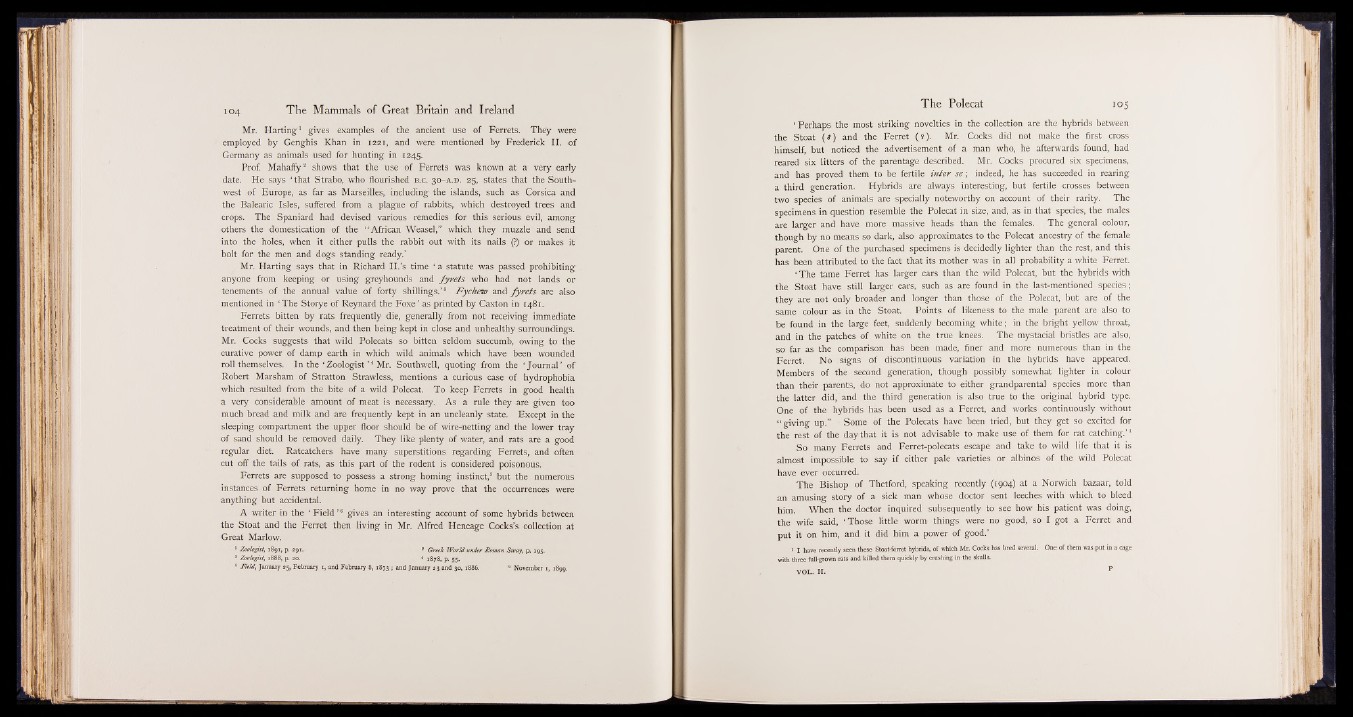
Mr. Harting1 gives examples of the ancient use of Ferrets. They were
employed by Genghis Khan in 12 21, and were mentioned by Frederick II. of
Germany as animals used for hunting in 1245.
Prof. Mahaffy2 shows that the use of Ferrets was known at a very early
date. He says ‘ that Strabo, who flourished b.c. 30-A.D. 25, states that the Southwest
of Europe, as far as Marseilles, including the islands, such as Corsica and
the Balearic Isles, suffered from a plague of rabbits, which destroyed trees and
crops. The Spaniard had devised various remedies for this serious evil, among
others the domestication of the “ African Weasel,” which they muzzle and send
into the holes, when it either pulls the rabbit out with its nails (?) or makes it
bolt for the men and dogs standing ready.’
Mr. Harting says that in Richard II .’s time ‘ a statute was passed prohibiting
anyone from keeping or using greyhounds and fy re ts who had not lands or
tenements of the annual value of forty shillings.’ 8 Fychew and fy re ts are also
mentioned in ‘ The Storye of Reynard the Foxe’ as printed by Caxton in 1481.
Ferrets bitten by rats frequently die, generally from not receiving immediate
treatment of their wounds, and then being kept in close and unhealthy surroundings.
Mr. Cocks suggests that wild Polecats so bitten seldom succumb, owing to the
curative power of damp earth in which wild animals which have been wounded
roll themselves. In the ‘ Zoologist’ 4 Mr. Southwell, quoting from the ‘ Journal’ of
Robert Marsham of Stratton Strawless, mentions a curious case of hydrophobia
which resulted from the bite of a wild Polecat. To keep Ferrets in good health
a very considerable amount of meat is necessary. As a rule they are given too
much bread and milk and are frequently kept in an uncleanly state. Except in the
sleeping compartment the upper floor should be of wire-netting and the lower tray
of sand should be removed daily. They like plenty of water, and rats are a good
regular diet. Ratcatchers have many superstitions regarding Ferrets, and often
cut off the tails of rats, as this part of the rodent is considered poisonous.
Ferrets are supposed to possess a strong homing instinct,6 but the numerous
instances of Ferrets returning home in no way prove that the occurrences were
anything but accidental.
A writer in the ‘ Field ’ 6 gives an interesting account of some hybrids between
the Stoat and the Ferret then living in Mr. Alfred Heneage Cocks’s collection at
Great Marlow.
1 Zoologist, 1891, p. 291. 2 Greek World under Roman Sway, p. 195.
3 Zoologist, 1888, p. 20. • , 4 tZ 'ji, p. 55.
6 Field, January 25, February 1, and February 8, 18 7 3 ; and January 23 and 30, 1886. 0 November 1, 1899.
‘ Perhaps the most striking novelties in the collection are the hybrids between
the Stoat ( * ) and the Ferret (?). Mr. Cocks did not make the first cross
himself, but noticed the advertisement of a man who, he afterwards found, had
reared six litters of the parentage described. Mr. Cocks procured six specimens,
and has proved them to be fertile in ter s e ; indeed, he has succeeded in rearing
a third generation. Hybrids are always interesting, but fertile crosses between
two species of animals are specially noteworthy on account of their rarity. The
specimens in question resemble the Polecat in size, and, as in that species, the males
are larger and have more massive heads than the females. The general colour,
though by no means so dark, also approximates to the Polecat ancestry of the female
parent. One of the purchased specimens is decidedly lighter than the rest, and this
has been attributed to the fact that its mother was in all probability a white Ferret.
‘ The tame Ferret has larger ears than the wild Polecat, but the hybrids with
the Stoat have still larger ears, such as are found in the last-mentioned species;
they are not only broader and longer than those of the Polecat, but are of the
same colour as in the Stoat. Points of likeness to the male parent are also to
be found in the large feet, suddenly becoming white; in the bright yellow throat,
and in the patches of white on the true knees. The mystacial bristles are also,
so far as the comparison has been made, finer and more numerous than in the
Ferret. No signs of discontinuous variation in the hybrids have appeared.
Members of the second generation, though possibly somewhat lighter in colour
than their parents, do not approximate to either grandparental species more than
the latter did, and the third generation is also true to the original hybrid type.
One of the hybrids has been used as a Ferret, and works continuously without
“ giving up.” Some of the Polecats have been tried, but they get so excited for
the rest of the day that it is not advisable to make use of them for rat catching.’ 1
So many Ferrets and Ferret-polecats escape and take to w ill ; life that it is
almost impossible to say if either pale varieties or albinos of the wild Polecat
have ever occurred.
The Bishop of Thetford, speaking recently (1904) at a Norwich bazaar, told
an amusing story of a sick man whose doctor sent leeches with which to bleed
him. When the doctor inquired subsequently to see how his patient was doing,
the wife said, ‘ Those little worm things were no good, so I got a Ferret and
put it on him, and it did him a power of good.’
1 1 have recently seen these Stoat-ferret hybrids, of which Mr. Cocks has bred several. One of them was put in a cage
with three full-grown rats and killed them quickly by crushing in the skulls.
VOL. II.